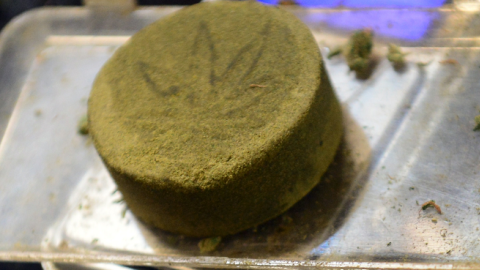A jury in Florida has awarded the staggering sum of $26.3 billion dollars in punitive damages to plaintiffs in a case against cigarette manufacturer R. J. Reynolds. The holding in the case was that plaintiffs needed no more than to show that the substance was known by the sellers to be addictive and to cause damage to health.
Sort of like marijuana, which is similarly known to medical science to be addictive, and to cause damage to health. It seems paradoxical that in states such as Colorado and Washington, under suspensions of federal law facilitated by the Obama Administration, marijuana production and sales are being encouraged, at the same time that tobacco products are being, quite properly, suppressed.
Apparently, voters were convinced to do so by the lure of potential tax revenue from distributing a known dangerous and addictive smoked substance. Recent research shows that high-school kids are more likely today to smoke marijuana than to initiate tobacco use. The world turned upside down.
Legalization advocates routinely misread this fact of less tobacco use. They hold that kids use more marijuana because it’s illegal, while tobacco, being regulated, can be controlled. (We’ll see how “controlled” in a moment.) Their conclusion is that marijuana should be regulated like tobacco. But tobacco was already regulated back when teen-age cigarette use was high. That can’t be the variable that explains its decline. Rather, we raised perceptions of health risks and norms of social disapproval against tobacco. It became unfashionable. We increasingly criminalized use in public areas. That, and we hammered the industry involved in the business of dealing toxins. This is the take-away lesson.
Ah, but we are told, the marijuana project is an “experiment.” Based on the results to date, showing undeniable and accelerating damage, it is time to end this sham experiment and acknowledge the mistake. We should do so before even more citizens, especially youth, are hurt.
Besides the promise of tax revenue for the state (a promise, by the way, that appears oversold — revenues in Colorado are short of expectations, and heavy users are turning back to the “medical marijuana” dispensaries, which are not subject to the “recreational” tax rate, to sustain their habit), voters in these states bit on what increasingly is revealed as a fraud. Moreover, the state of Colorado has yet to come to grips with the costs being imposed by expanding marijuana use, costs to public safety and public health, to addiction treatment services, and to school and workplace performance. (We can be thankful no one is distributing untaxed tobacco through “medical” dispensaries, as an “experiment.”)
There was one other rationale for legal marijuana advocates; that it would somehow reduce criminal involvement because the prohibition on the drug would cease. Youth, it was said, were already getting and using marijuana, by virtue of a black market controlled by cartels. Let’s use the tobacco model. Because prohibition increases the price for the drug and attracts violence, we should make it make it accessible and regulated. That should drive out criminals and make marijuana cheaper, safer, and did we mention provide funding for the state?
All in all, legalization would be a contribution towards the philosophy of “harm reduction” whereby one doesn’t seek to prohibit a dangerous behavior but rather, tries to manage its consequences. This maneuver also has been revealed as a fraud. In Colorado, the black market thrives, and the state has even become the source of large-scale interstate smuggling.
What advocates neglected is that the taxation penalty is also a form of prohibition. This fact is well known to researchers and can be demonstrated by tobacco. Remember the argument that it was “regulated”? Cigarettes are the most widely smuggled legal substance in the world. That smuggling is controlled by criminal cartels, is based on violence, and is enormously profitable.
Academic studies have repeatedly argued that the more one imposes penalties (such as taxes) on a substance, particularly an addictive one, the higher the prices, the greater the efforts to evade, and the greater willingness of criminals to meet that demand, including the willingness to commit violence to protect their monopoly. A recent Washington Post story on how cigarette smuggling was being used to fund terrorist organizations noted that a single truck full of contraband cigarettes can yield $2 million in profits.
Why is a legal but addictive substance, tobacco, being smuggled, both interstate, domestically, as well as internationally, by organized crime? To avoid the penalty of taxes. The experiment in Colorado is perverse: because of legalized access, abetted by blatant advertising and loss of risk, the number of users is increased, including the percentage who are dependent, heavy users. As more of the drug is smoked, more profit will be generated, for an industry that will reinvest those profits to protect and expand its market.
But because of the taxes, which will likely increase to meet the costs imposed by use of the drug, the heaviest users resort to cheaper, untaxed sources, such as medical dispensaries. And to the reliable black market, which is also reaping enormous profits, and is willing to ensure its grasp on addiction and money by whatever means necessary. As we have learned before.
Some experiment. The outcome is foreseeable, tragic, and avoidable. In genuine medical trials or indeed any experiment involving human subjects, there is an overwhelming ethical obligation entailed by the research. When it becomes undeniable that the experimental intervention is actively harming subjects, the trial must be stopped.
The distribution of marijuana, addictive and harmful, meets these criteria, and the costs vastly outweigh whatever benefit was supposed to accrue to society or the individual. It is time for responsible public officials to stop playing along, and shut this failed experiment down.




















